Impact of Users’ Behavior and Real Weather Conditions on the Energy Consumption of Tenement Houses in Wroclaw, Poland: Energy Performance Gap Simulation Based on a Model Calibrated by Field Measurements
Abstract
1. Introduction
2. Materials and Methods
2.1. Aim of the Research
2.2. Subject of Study
2.3. Measurements
2.4. Computational Models
2.5. Simulations
- Simulation 0: The results show the actual final energy consumption for space heating and DHW preparation during the research period (14 January to 9 March 2020). The results of this simulation correspond to the apartment use conditions (see Table 3) and weather conditions observed during the tests.
- Simulation 1: The results show the final energy consumption for space heating and DHW preparation in the research period for the weather conditions observed during the tests, but for the proper use of the apartment. The proper use is defined by interior temperature, ventilation level and DHW consumption as described below the interior temperature in the apartments was changed to comply with the requirements of Polish regulations [32], i.e., 20 °C in residential rooms and 24 °C in bathrooms. The ventilation level was assumed to meet the hygienic minimum [33], which should allow the CO2 concentration to be maintained at the appropriate level. DHW consumption was assumed at the level of 40 L/day per person (which corresponds to the average DHW consumption in all analyzed premises).
- Simulation 2: The results show the final energy consumption for space heating and DHW preparation in the research period for proper use of the apartment, as described in simulation 1, but for weather conditions corresponding to the data used in engineering calculations [28].
- Simulation 3: The results show the final energy consumption for space heating and DHW preparation in the research period for the weather conditions corresponding to the data used in engineering calculations [28] and for the use of the premises described as standard in engineering calculations of energy demand [32].
- Simulation 4: The results show the final energy consumption for space heating and DHW preparation in the research period for the weather conditions observed during the tests and for the use of the premises described as standard in engineering calculations of energy demand [32].
2.6. Methods of Energy Performance Gap Calculation
3. Results and Discussion
3.1. Final Energy Use: Measurement vs. Calculation
3.2. Energy Performance Gap
4. Conclusions
Author Contributions
Funding
Conflicts of Interest
Nomenclature
| DHW | Domestic hot water |
| Apartment numbers | |
| Average heat transfer coefficient, W/m2K | |
| Internal temperature, | |
| Domestic hot water consumption, | |
| Domestic hot water temperature, | |
| Internal gains, | |
| Energy performance gap for space heating | |
| Energy performance gap for domestic hot water preparation | |
| Energy performance gap for space heating and domestic hot water production | |
| Final energy for space heating, | |
| Final energy for domestic hot water preparation, | |
| Simulation numbers |
References
- Directive (EU) 2018/2002 of the European Parliament and of the Council of 11 December 2018 Amending Directive 2012/27/EU on Energy Efficiency. 2018. Available online: http://data.europa.eu/eli/dir/2018/2002/oj (accessed on 18 December 2020).
- Baborska-Narożny, M.; Szulgowska-Zgrzywa, M.; Piechurski, K.; Stefanowicz, E.; Fidorów-Kaprawy, N.; Laska, M.; Machyńska, A.; Chmielewska, A.; Wójcik, F. Źródła Ciepła na Paliwo Stałe w Budynkach Mieszkalnych we Wrocławiu. 2019. Available online: https://bip.um.wroc.pl/attachments/download/80120. (accessed on 17 December 2020).
- Reinhart, C.F.; Davila, C.C. Urban building energy modeling—A review of a nascent field. Build. Environ. 2016, 97, 196–202. [Google Scholar] [CrossRef]
- Frayssinet, L.; Merlier, L.; Kuznik, F.; Hubert, J.-L.; Milliez, M.; Roux, J.-J. Modeling the heating and cooling energy demand of urban buildings at city scale. Renew. Sustain. Energy Rev. 2018, 81, 2318–2327. [Google Scholar] [CrossRef]
- Kazas, G.; Fabrizio, E.; Perino, M. Energy demand profile generation with detailed time resolution at an urban district scale: A reference building approach and case study. Appl. Energy 2017, 193, 243–262. [Google Scholar] [CrossRef]
- Aksoezen, M.; Daniel, M.; Hassler, U.; Kohler, N. Building age as an indicator for energy consumption. Energy Build. 2015, 87, 74–86. [Google Scholar] [CrossRef]
- Zou, P.X.W.; Xu, X.; Sanjayan, J.; Wang, J. Review of 10 years research on building energy performance gap: Life-cycle and stakeholder perspectives. Energy Build. 2018, 178, 165–181. [Google Scholar] [CrossRef]
- Calì, D.; Osterhage, T.; Streblow, R.; Müller, D. Energy performance gap in refurbished German dwellings: Lesson learned from a field test. Energy Build. 2016, 127, 1146–1158. [Google Scholar] [CrossRef]
- De Wilde, P. The gap between predicted and measured energy performance of buildings: A framework for investigation. Autom. Constr. 2014, 41, 40–49. [Google Scholar] [CrossRef]
- Kowalski, P.; Szałański, P. Computational and the real energy performance of a single-family residential building in Poland—An attempt to compare: A case study. E3S Web Conf. 2017, 17, 00045. [Google Scholar] [CrossRef]
- Galvin, R. Making the “rebound effect” more useful for performance evaluation of thermal retrofits of existing homes: Defining the “energy savings deficit” and the “energy performance gap”. Energy Build. 2014, 69, 515–524. [Google Scholar] [CrossRef]
- Jevons, W.S. The Coal Question: An Inquiry Concerning the Progress of the Nation, and the Probable Exhaustion of Our Coal-Mines; Macmillan and Co.: London, UK; Cambridge, UK, 1865. [Google Scholar]
- Maxwell, D.; Owen, P.; McAndrew, L.; Muehmel, K.; Neubauer, A. Addressing the Rebound Effect, A Report for the European Commission DG Environment; European Commission DG ENV: Ivry-sur-Seine, France, 2011. [Google Scholar]
- Galvin, R.; Sunikka-Blank, M. Quantification of (p)rebound effects in retrofit policies—Why does it matter? Energy 2016, 95, 415–424. [Google Scholar] [CrossRef]
- Pisello, A.L.; Piselli, C.; Cotana, F. Influence of human behavior on cool roof effect for summer cooling. Build. Environ. 2015, 88, 116–128. [Google Scholar] [CrossRef]
- Al-Mumin, A.; Khattab, O.; Sridhar, G. Occupants’ behavior and activity patterns influencing the energy consumption in the Kuwaiti residences. Energy Build. 2003, 35, 549–559. [Google Scholar] [CrossRef]
- De Meester, T.; Marique, A.-F.; De Herde, A.; Reiter, S. Impacts of occupant behaviours on residential heating consumption for detached houses in a temperate climate in the northern part of Europe. Energy Build. 2013, 57, 313–323. [Google Scholar] [CrossRef]
- Yu, Z.; Fung, B.C.M.; Haghighat, F.; Yoshino, H.; Morofsky, E. A systematic procedure to study the influence of occupant behavior on building energy consumption. Energy Build. 2011, 43, 1409–1417. [Google Scholar] [CrossRef]
- Guerra Santin, O.; Itard, L.; Visscher, H. The effect of occupancy and building characteristics on energy use for space and water heating in Dutch residential stock. Energy Build. 2009, 41, 1223–1232. [Google Scholar] [CrossRef]
- Kashif, A.; Ploix, S.; Dugdale, J.; Le, X.H.B. Simulating the dynamics of occupant behaviour for power management in residential buildings. Energy Build. 2013, 56, 85–93. [Google Scholar] [CrossRef]
- De Groot, E.; Spiekman, M.; Opstelten, I. Dutch research into user behavior in relation to energy use of residences. In Proceedings of the PLEA 2008—25th Conference on Passive and Low Energy Architecture, Dublin, Ireland, 22–24 October 2008. [Google Scholar]
- Menezes, A.C.; Cripps, A.; Bouchlaghem, D.; Buswell, R. Predicted vs. actual energy performance of non-domestic buildings: Using post-occupancy evaluation data to reduce the performance gap. Appl. Energy 2012, 97, 355–364. [Google Scholar] [CrossRef]
- Dall’O’, G.; Sarto, L.; Galante, A.; Pasetti, G. Comparison between predicted and actual energy performance for winter heating in high-performance residential buildings in the Lombardy region (Italy). Energy Build. 2012, 47, 247–253. [Google Scholar] [CrossRef]
- Lopes, M.A.R.; Antunes, C.H.; Martins, N. Energy behaviours as promoters of energy efficiency: A 21st century review. Renew. Sustain. Energy Rev. 2012, 16, 4095–4104. [Google Scholar] [CrossRef]
- Paone, A.; Bacher, J.-P. The Impact of Building Occupant Behavior on Energy Efficiency and Methods to Influence It: A Review of the State of the Art. Energies 2018, 11, 953. [Google Scholar] [CrossRef]
- Baborska-Narożny, M.; Szulgowska-Zgrzywa, M.; Fidorów-Kaprawy, N.; Chmielewska, A.; Laska, M.; Stefanowicz, E.; Piechurski, K. Ciepło w Domu Gdy Zimno na Dworze. 2018. Available online: h8p://w-r.com.pl/projekty/cieplozimno/ (accessed on 20 October 2020).
- International Organization for Standardization. ISO 52016-1:2017, Energy Performance of Buildings—Energy Needs for Heating and Cooling, Internal Temperatures and Sensible and Latent Heat Loads—Part 1: Calculation Procedures; ISO: Geneva, Switzerland, 2017. (In Polish) [Google Scholar]
- Polish Minister of Infrastructure and Economic Development. Regulation of the Polish Minister of the Infrastructure and Economic Development of 21 February 2015 on the methodology for determining of building or part of the building and energy performance certificates. J. Laws 2015, 376. (In Polish) [Google Scholar]
- Ministry of Investment and Development. Data for Buildings Energy Calculations. Available online: https://dane.gov.pl/pl/dataset/797,typowe-lata-meteorologiczne-i-statystyczne-dane-klimatyczne-dla-obszaru-polski-do-obliczen-energetycznych-budynkow (accessed on 22 October 2020).
- Remund, J.; Müller, S.; Schmutz, M.; Gra, P. Meteonorm: Global Meteorogical Database for Solar Energy and Applied, 7-11/IX/2020, Version 8. In Proceedings of the 35th European PV Solar Energy Conference and Exhibition (EUPVSEC 2018), Brussels, Belgium, 24–28 September 2018. [Google Scholar]
- Baborska-Narożny, M.; Szulgowska-Zgrzywa, M.; Mokrzecka, M.; Chmielewska, A.; Fidorow-Kaprawy, N.; Stefanowicz, E.; Piechurski, K.; Laska, M. Climate justice: Air quality and transitions from solid fuel heating. Build. Cities 2020, 1, 120–140. [Google Scholar] [CrossRef]
- Polish Minister of Infrastructure and Economic Development. Regulation of the Polish Minister of the Infrastructure and Economic Development of 12 April 2002 on the Technical Conditions, Which Are to Be Met by Buildings and Their Location. J. Laws 2002. (In Polish) [Google Scholar]
- Polish Normalization Committee. PN-83/B-03430/Az3:2000 Ventilation in Residential Buildings of Collective Residence and Public Utility Buildings—Requirements. 2000; (In Polish). Available online: http://www.iko.pwr.wroc.pl/PracowDrct/Agnieszka_Zajac/_PN-83_B-03430_doc.pdf (accessed on 18 December 2020).
- Chmielewska, A.; Szulgowska-Zgrzywa, M.; Danielewicz, J. Domestic hot water consumption in multiapartment buildings. E3S Web Conf. 2017, 17, 00014. [Google Scholar] [CrossRef]
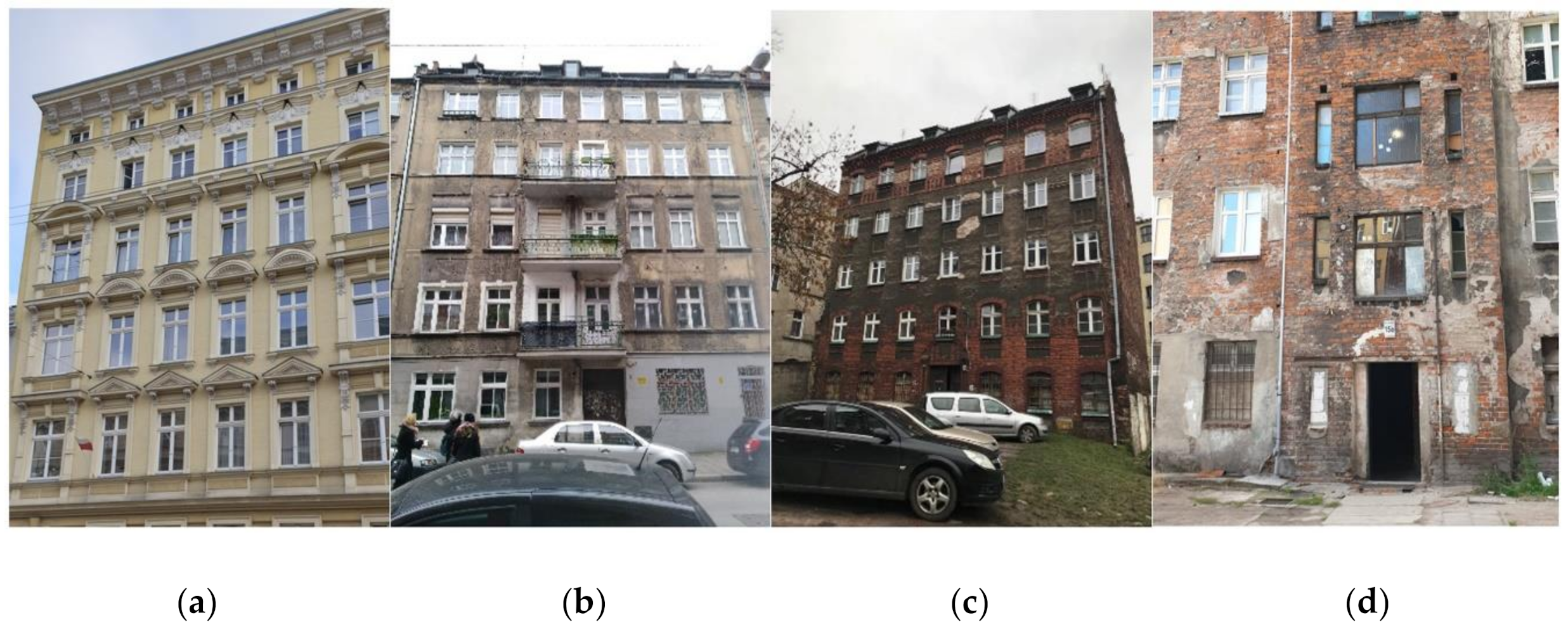

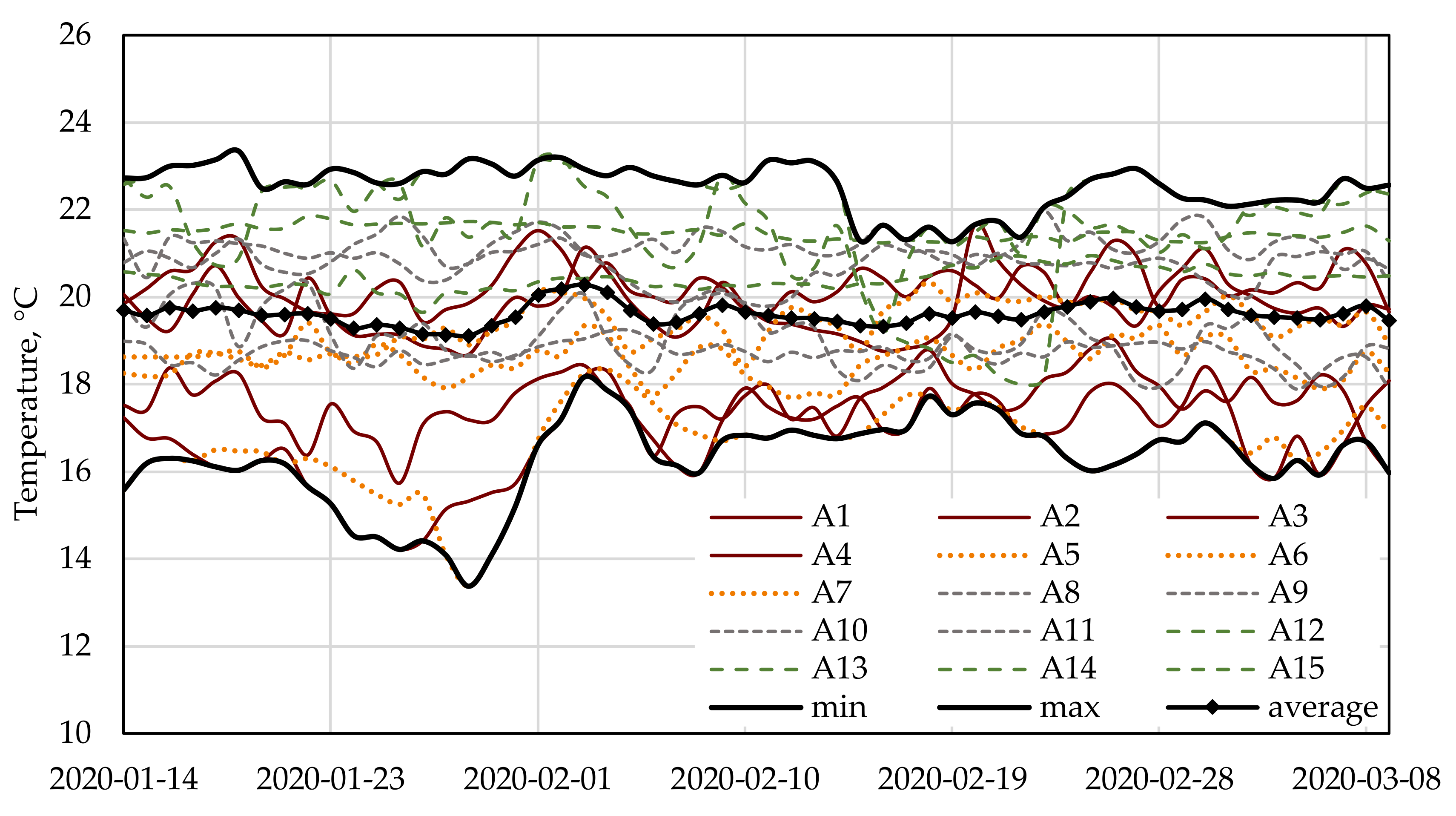
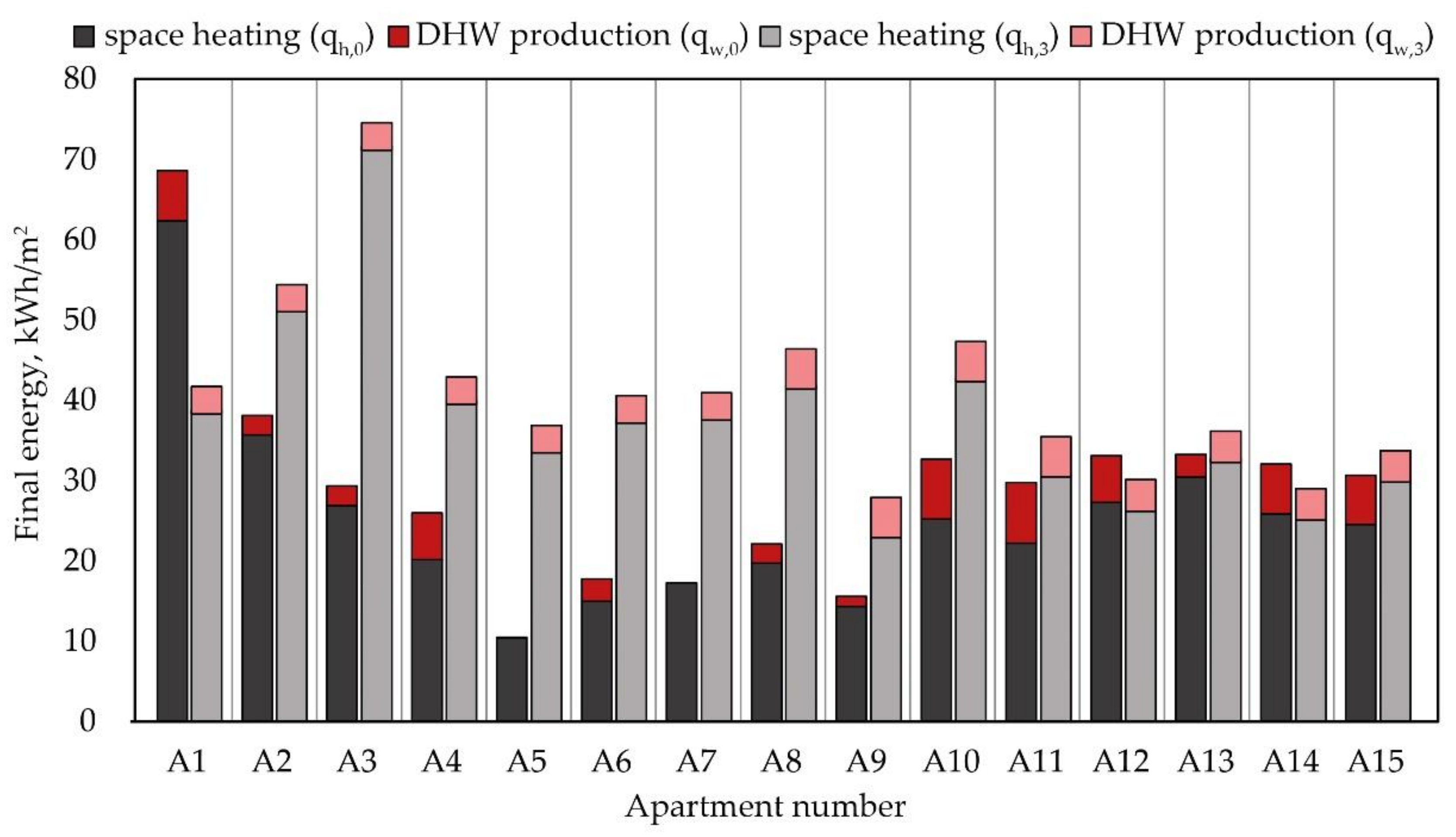

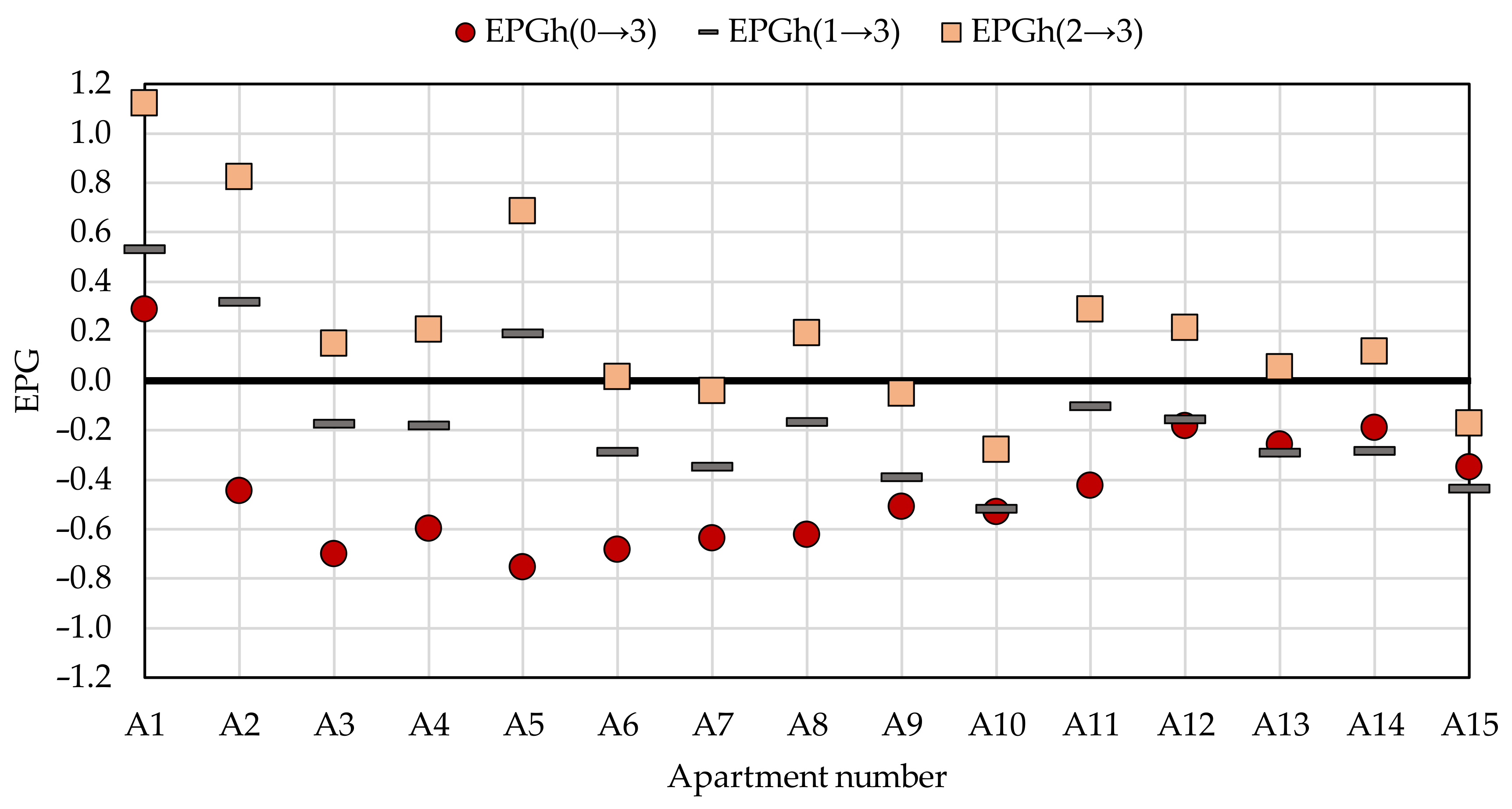
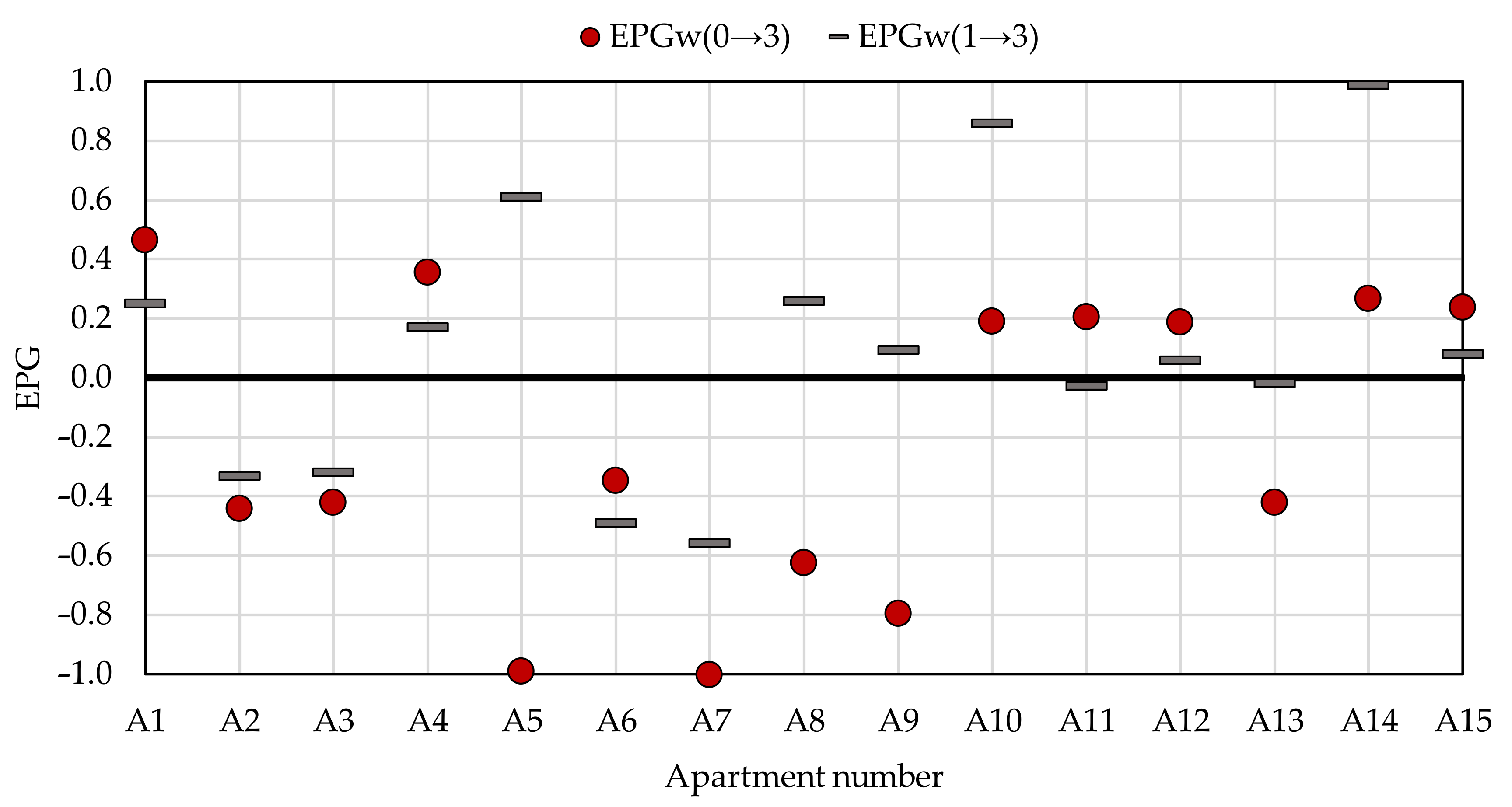
| Apartment Number | Flat Area (m2) | Heating Source | DHW Production Source | Location/Orientation of the Window | Technical Condition of Building/Uavg Value [W/m2K] | Tenants |
|---|---|---|---|---|---|---|
| A1 | 44.4 | SF + EE | EE | middle floor; corner/NW | very bad/0.98 | couple |
| A2 | 41.5 | SF | EE | middle floor; corner/SW | very bad/1.02 | retired lady |
| A3 | 40.7 | SF | EE | attic; corner/SE | bad/0.97 | retired lady |
| A4 | 47.4 | SF | EE | middle floor; one-sided/SW | very bad/0.99 | mother and daughter |
| A5 | 34.5 | EE | EE | middle floor; corner/SW | very bad/0.93 | elderly couple |
| A6 | 54.5 | EE | EE | attic; corner/NE | very bad/0.88 | mother and son |
| A7 | 62.9 | EE | EE | attic; one-sided/NE | bad/1.00 | single woman |
| A8 | 44.1 | DH | DH | ground floor; one-sided/SW | average/0.85 | couple |
| A9 | 76.1 | DH | DH | middle floor; two-sided/SE | good/1.20 | couple + single |
| A10 | 59.8 | DH + EE | DH | ground floor; corner/NE, E, SE | good/0.68 | family (4) |
| A11 | 85.5 | DH | DH | mid. floor; two-sided/SW, NE | average/1.08 | family (3) |
| A12 | 52.5 | NG | NG | mid. floor; two-sided/SW, NE | good/0.75 | young couple |
| A13 | 85.0 | NG | NG | mid. floor; two-sided/SW, NE | average/1.03 | multigenerational family |
| A14 | 55.9 | NG | NG | middle floor; corner/SW | good/0.74 | family (4) |
| A15 | 128.5 | NG | NG | mid. floor; two-sided/SE, NW | good/0.67 | multigenerational family |
| Measuring Device | Producer | Type | Measuring Accuracy |
|---|---|---|---|
| Energy data logger | Voltcraft | 4000 | 1% |
| Gas volume meter | Plum | MacR6 | according to meter type 1 impulse = 0.01 m3 |
| Two-channel temperature recorder | Testo | 175-T3 | ±0.5 °C (−50 to +70 °C) |
| Clamp-on water temperature probe | Testo | K-type | class 1 |
| One-channel temperature recorder | Testo | 176-T1 | ±0.3 °C (−100 to +70 °C) |
| Two-channel temperature and humidity recorder | Testo | 174H | ±0.5 °C (–20 to +70 °C); ±3% RH (2 to 98% RH) at +25 °C ±0.03% RH/K |
| Two-channel temperature recorder with surface temperature probes | Testo | 175-T2 NTC | ±0.5% (–35 to +55 °C); ext. sens.: ±0.2 °C (−25 to +80 °C) |
| Hook scale | Steinberg | – | 2–300 kg; class 3 |
| Temperature, humidity, and CO2 recorder | Comet System | Test-Therm | ±1.8% RH; ±1.5 °C; ± (50 ppm + 2% measured value) for 25 °C and 1013 hPa |
| Humidity and temperature probes | Vaisala | HMP45 | ±0.2 °C (at +20 °C) |
| Pyranometer | Kipp and Zonen | CMP3 | <5% (–10 to +40 °C) |
| Parameter | A1 | A2 | A3 | A4 | A5 | A6 | A7 | A8 | A9 | A10 | A11 | A12 | A13 | A14 | A15 |
|---|---|---|---|---|---|---|---|---|---|---|---|---|---|---|---|
| Tint, °C | 20.3 | 16.7 | 17.6 | 19.7 | 16.6 | 18.5 | 19.4 | 18.7 | 21.1 | 20.8 | 19.1 | 21.9 | 20.4 | 21.9 | 21.5 |
| VDHW, L/d pp | 60.7 | 41.1 | 48.4 | 83.0 | 0.5 | 60.7 | 0.0 | 14.6 | 8.3 | 26.8 | 50.6 | 53.6 | 24.6 | 39.2 | 51.8 |
| TDHW, °C | 49.6 | 46.7 | 44.9 | 39.1 | 39.5 | 50.4 | - | 41.8 | 44.3 | 48.0 | 48.8 | 51.9 | 55.8 | 52.0 | 52.0 |
| CO2, ppm | 848 | 829 | 1860 | 2452 | 2931 | 1374 | 774 | 2413 | 1927 | 976 | 992 | 1025 | 885 | 855 | 993 |
| qint, W/m2 | 3.4 | 2.7 | 2.7 | 3.0 | 5.2 | 2.8 | 1.7 | 4.3 | 3.5 | 4.8 | 2.6 | 3.4 | 3.8 | 5.5 | 2.3 |
| qH, kWh/m2 | 62.3 | 35.7 | 26.9 | 20.2 | 10.4 | 15.0 | 17.3 | 19.7 | 14.3 | 25.2 | 22.2 | 27.2 | 30.4 | 25.9 | 24.6 |
| qW, kWh/m2 | 6.3 | 2.4 | 2.5 | 5.8 | 0.0 | 2.8 | 0.0 | 2.4 | 1.3 | 7.5 | 7.5 | 5.8 | 2.8 | 6.2 | 6.1 |
| Parameter | A1 | A2 | A3 | A4 | A5 | A6 | A7 | A8 | A9 | A10 | A11 | A12 | A13 | A14 | A15 |
|---|---|---|---|---|---|---|---|---|---|---|---|---|---|---|---|
| EPGh+w(0→3) | 0.30 | −0.44 | −0.69 | −0.52 | −0.78 | −0.65 | −0.67 | −0.62 | −0.56 | −0.45 | −0.34 | −0.13 | −0.27 | −0.13 | −0.28 |
| EPGh(0→3) | 0.29 | −0.44 | −0.70 | −0.60 | −0.75 | −0.68 | −0.64 | −0.62 | −0.51 | −0.53 | −0.42 | −0.18 | −0.26 | −0.19 | −0.35 |
| EPGh(1→3) | 0.53 | 0.32 | −0.18 | −0.18 | 0.19 | −0.29 | −0.35 | −0.17 | −0.39 | −0.52 | −0.10 | −0.16 | −0.29 | −0.28 | −0.44 |
| EPGh(2→3) | 1.12 | 0.83 | 0.15 | 0.21 | 0.69 | 0.02 | −0.04 | 0.20 | −0.05 | −0.28 | 0.29 | 0.21 | 0.06 | 0.12 | −0.17 |
| EPGh(4→3) | −0.34 | −0.33 | −0.31 | −0.36 | −0.33 | −0.32 | −0.35 | −0.33 | −0.39 | −0.33 | −0.35 | −0.35 | −0.36 | −0.38 | −0.34 |
| EPGw(0→3) | 0.47 | −0.44 | −0.42 | 0.36 | −0.99 | −0.34 | −1.00 | −0.62 | −0.80 | 0.19 | 0.21 | 0.19 | −0.42 | 0.27 | 0.24 |
| EPGw(1→3) | 0.25 | −0.33 | −0.32 | 0.17 | 0.61 | −0.49 | −0.56 | 0.26 | 0.10 | 0.86 | −0.03 | 0.06 | −0.02 | 0.99 | 0.08 |
Publisher’s Note: MDPI stays neutral with regard to jurisdictional claims in published maps and institutional affiliations. |
© 2020 by the authors. Licensee MDPI, Basel, Switzerland. This article is an open access article distributed under the terms and conditions of the Creative Commons Attribution (CC BY) license (http://creativecommons.org/licenses/by/4.0/).
Share and Cite
Szulgowska-Zgrzywa, M.; Stefanowicz, E.; Piechurski, K.; Chmielewska, A.; Kowalczyk, M. Impact of Users’ Behavior and Real Weather Conditions on the Energy Consumption of Tenement Houses in Wroclaw, Poland: Energy Performance Gap Simulation Based on a Model Calibrated by Field Measurements. Energies 2020, 13, 6707. https://doi.org/10.3390/en13246707
Szulgowska-Zgrzywa M, Stefanowicz E, Piechurski K, Chmielewska A, Kowalczyk M. Impact of Users’ Behavior and Real Weather Conditions on the Energy Consumption of Tenement Houses in Wroclaw, Poland: Energy Performance Gap Simulation Based on a Model Calibrated by Field Measurements. Energies. 2020; 13(24):6707. https://doi.org/10.3390/en13246707
Chicago/Turabian StyleSzulgowska-Zgrzywa, Małgorzata, Ewelina Stefanowicz, Krzysztof Piechurski, Agnieszka Chmielewska, and Marek Kowalczyk. 2020. "Impact of Users’ Behavior and Real Weather Conditions on the Energy Consumption of Tenement Houses in Wroclaw, Poland: Energy Performance Gap Simulation Based on a Model Calibrated by Field Measurements" Energies 13, no. 24: 6707. https://doi.org/10.3390/en13246707
APA StyleSzulgowska-Zgrzywa, M., Stefanowicz, E., Piechurski, K., Chmielewska, A., & Kowalczyk, M. (2020). Impact of Users’ Behavior and Real Weather Conditions on the Energy Consumption of Tenement Houses in Wroclaw, Poland: Energy Performance Gap Simulation Based on a Model Calibrated by Field Measurements. Energies, 13(24), 6707. https://doi.org/10.3390/en13246707






